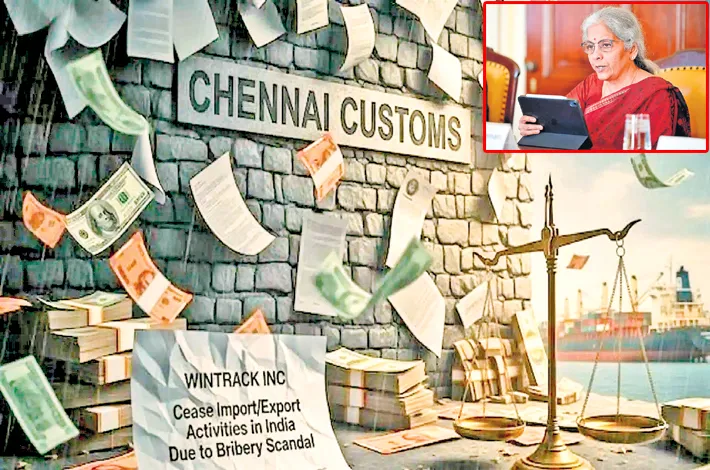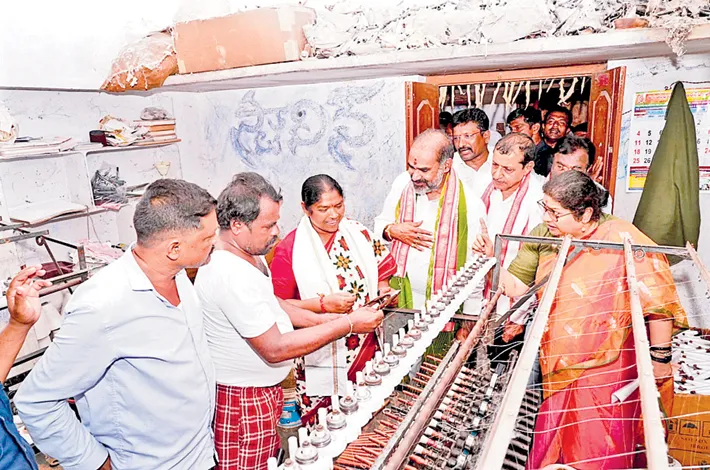Bureaucratic impediments Open secret hindering business in India?
06-10-2025 12:00:00 AM

Recently, Wintrack Inc., a Tamil Nadu-based import-export company specializing in personal care products, announced it was shutting down its operations in India effective October 1, 2025. The company’s founder, Prawin Ganeshan, cited systemic harassment, alleged bribery demands, and retaliatory actions by Chennai Customs officials as the primary reasons for the closure. This high-profile case has ignited a national conversation about the persistent bureaucratic hurdles that undermine India’s “Ease of Doing Business” initiatives.
While the government has launched reforms to streamline processes, the Wintrack incident reveals how entrenched bureaucratic practices, coupled with allegations of corruption and regulatory overreach, continue to impede businesses, particularly small and medium enterprises (SMEs). This article explores the Wintrack-Chennai Customs dispute through the lens of bureaucratic impediments, weaving together diverse perspectives from entrepreneurs, policymakers, industry experts, and customs officials to paint a comprehensive picture of the challenges and potential solutions.
The Wintrack case: Representation of bureaucratic challenges
Wintrack’s troubles began in January 2025, when customs officials allegedly demanded Rs 8 lakh in bribes for a $1,300 shipment, a sum exceeding 60% of the consignment’s value. According to the company’s founder Prawin Ganeshan, similar demands followed in May (Rs 5 lakh, settled at Rs 3 lakh) and August. Frustrated, he recorded conversations with agents, posted them on social media platform X, and accused officials of systemic corruption. While these exposés temporarily secured shipment releases, they triggered what Ganeshan described as “retaliatory harassment.”
Over the 45 days leading to the shutdown, officials reportedly delayed shipments by nitpicking declarations (e.g., charging cables not listed separately), demanding compliance with obscure regulations like the Extended Producer Responsibility (EPR) and Lead Management Program Certificate (LMPC), and imposing demurrage fees that crippled Wintrack’s operations. In an emotional X video, Ganeshan claimed the stress caused health issues, underscoring the personal toll of bureaucratic battles.
Chennai Customs, in response dismissed the allegations as “false and unsubstantiated,” arguing that Wintrack’s issues stemmed from legitimate violations, including misdeclaration, misclassification, and non-compliance with safety and environmental standards like the Bureau of Indian Standards (BIS) and EPR. They accused Wintrack of creating a “selective narrative” to pressure officials into bypassing scrutiny, noting the company’s pattern of deleting critical X posts after facts were presented. The Union Finance Ministry intervened, ordering a “fair, transparent, and fact-based inquiry” by the Department of Revenue to investigate both sides.
Bureaucracy as a barrier: The entrepreneur’s perspective
For entrepreneurs like Ganeshan, the Wintrack case symbolizes the bureaucratic struggles that small businesses face in India. SMEs, which contribute 30% to India’s GDP and employ over 110 million people, often lack the resources to navigate complex regulatory frameworks. Ganeshan’s allegations of bribe demands resonate with many traders who report similar experiences. A Chennai-based importer described customs clearance as a “black box” where agents act as intermediaries, demanding “speed money” to expedite processes. He stated that if one refuses, the shipment is kept aside, racking up demurrage fees(fee charged when containers stay in a port or terminal beyond the allowed "free time).This lack of tranparency and discretionary power create an uneven playing field, where compliance becomes secondary to influence or payments.
Industry bodies like the Federation of Indian Chambers of Commerce and Industry (FICCI) have long highlighted bureaucratic delays as a key impediment. A 2024 FICCI survey found that 62% of SMEs reported delays in customs clearance due to inconsistent rule interpretation or excessive documentation. For Wintrack, the sudden enforcement of EPR and LMPC requirements—allegedly not demanded in prior shipments—illustrates this inconsistency. “Rules are applied selectively to punish or extort,” Ganeshan claimed in a post on X. Such experiences discourage entrepreneurs from scaling up operations, with some, like Wintrack, choosing to exit entirely. FICCI and the Confederation of Indian Industry (CII) advocate for structural reforms, such as digitizing all customs processes and reducing the number of agencies involved. A top CII office bearer called for a “single-point clearance system” in a 2025 statement, arguing it would curb discretionary powers.
The customs perspective: Regulation vs. harassment
Customs officials, however, argue that their actions are driven by the need to enforce compliance with India’s complex regulatory framework. A senior Chennai Customs officer explained that import processes involve multiple agencies, including the Directorate General of Foreign Trade (DGFT), Bureau of Indian Standards(BIS) and environmental regulators, each with distinct mandates. He mentioned that false declarations, even minor ones, could trigger scrutiny to prevent revenue leakage or unsafe goods entering the market. In Wintrack’s case, officials cited non-compliance with BIS standards for electronic goods and EPR for waste management as legitimate reasons for delays.
Yet, critics argue that the system’s complexity enables discretionary enforcement. A former top official of NITI Aayog, noted in a 2025 op-ed that India’s customs processes involve over 40 documents for a single shipment, compared to 10-15 in Singapore or South Korea. This “bundle” of regulations—BIS, EPR, LMPC, and more—creates opportunities for rent-seeking. The Wintrack case suggests that even compliant businesses can face delays if they challenge the status quo, as Ganeshan did by exposing alleged corruption.
Government reforms and their limits
India has made strides to improve its Ease of Doing Business ranking, climbing from 142nd in 2014 to 63rd in 2020 (World Bank’s last report before discontinuing the index). Initiatives like faceless customs assessments, the National Single Window System, and the Taxpayer Charter aim to reduce human intervention and streamline processes. The Central Board of Indirect Taxes and Customs (CBIC) claims a 40% reduction in clearance times since 2019, with 80% of shipments now processed within 48 hours. However, the Wintrack case exposes gaps in implementation, particularly at the ground level.
A policy analyst at the Centre for Policy Research (CPR) argued that reforms often fail to address the “last-mile problem.” She remarked that Digital systems exist, but officers retain significant discretion, especially in smaller ports like Chennai. The reliance on intermediaries like clearing agents, who often broker informal payments, further undermines reforms. In Wintrack’s case, Ganeshan’s recorded conversations with agents suggest a well-entrenched system where bribes are normalized as “facilitation fees.” The government’s swift response to the Wintrack case—ordering an inquiry—signals awareness of the issue’s gravity.
Finance Minister Nirmala Sitharaman emphasized the government’s commitment to a “business-friendly environment” in a statement on October 3, 2025. Yet, skepticism persists. A Mumbai-based exporter told Mint that inquiries often fizzle out, with junior officers being made scapegoats while systemic issues remain unaddressed. Historical cases, such as CBI raids on corrupt customs officers in Delhi (2015) and Mumbai (2023), highlight the challenge of rooting out entrenched practices.
The Wintrack case is not an isolated incident but a symptom of broader systemic issues that affect India’s economic ambitions. As the country aims to become a $5 trillion economy by 2027, SMEs and exporters are critical drivers. However, bureaucratic inefficiencies deter investment and innovation. A 2025 World Trade Organization report noted that India’s trade facilitation costs are 15-20% higher than those of ASEAN peers, partly due to customs delays. For businesses like Wintrack, these costs translate into lost revenue, eroded trust, and, in extreme cases, closure.
The case also risks damaging India’s image as a global trade hub. With initiatives like “Make in India” and the Production-Linked Incentive (PLI) scheme, the government seeks to attract foreign investment. However, stories of harassment and shutdowns, amplified by social media platforms like X, can deter investors. A Singapore-based logistics consultant told The Financial Express that multinationals closely monitor such incidents when deciding on supply chain hubs. “India competes with Vietnam and Thailand, where clearance is faster and less discretionary,” he said. The Wintrack case, trending on X with hashtags like #StopCustomsCorruption, amplifies these concerns, potentially discouraging foreign SMEs from entering the Indian market.
The ripple effects extend beyond the company itself. Employees, suppliers, and local communities dependent on SMEs suffer when businesses shut down. For instance, Wintrack’s closure may have impacted its workforce, potentially pushing skilled workers into informal sectors or unemployment. A 2025 report by the International Labour Organization noted that SMEs in developing economies like India are critical for job creation, particularly for youth and women. When such businesses collapse due to systemic issues, it undermines efforts to reduce poverty and inequality, key pillars of India’s development agenda.
The Wintrack dispute has sparked a range of opinions, reflecting the complexity of the issue. Many echo Ganeshan’s frustration, viewing bureaucracy as a tool for extortion. A Delhi-based trader posted on X comparing the customs department with “mafia”. “Pay up or your business dies” was the normal tone expressed highlighting the power imbalance between small businesses and officials. While defending their actions, some officials however acknowledge the need for reform. A retired CBIC officer opined that training and accountability measures could reduce friction, but “businesses must also comply with rules to avoid delays.”
Addressing bureaucratic impediments requires a multi-pronged approach. First, simplifying regulations is critical. Reducing the number of mandatory certifications and standardizing requirements across ports could minimize discretionary enforcement. For instance, consolidating BIS, EPR, and LMPC requirements into a single compliance framework could reduce confusion. Second, full digitization of customs processes, with zero human intervention for routine clearances, could curb bribe demands. Singapore’s TradeNet system, which processes 99% of permits within 10 minutes, offers a model.
Third, accountability mechanisms must be strengthened. The government’s inquiry into the Wintrack case is a start, but independent oversight bodies, as suggested by FICCI, could ensure transparency. Fourth, training programs for customs officers, focusing on customer-centric service, could shift the culture from adversarial to collaborative. Fifth, empowering SMEs with legal and financial support to challenge unfair practices could level the playing field. Establishing dedicated grievance cells for importers, with fast-track resolution mechanisms, could prevent cases like Wintrack’s from escalating to closure.
Finally, fostering public-private dialogue is essential. Regular consultations between CBIC, industry bodies, and SMEs could align regulations with business needs. Pilot programs in major ports, testing streamlined clearance processes, could provide data to scale reforms nationwide. The Wintrack case underscores the urgency of these measures, as every lost business represents lost jobs, innovation, and economic potential.
Mitigating bureaucratic challenges through tech
Blockchain technology, for instance, could revolutionize customs processes by creating immutable records of transactions and compliance documents. Countries like Singapore and the UAE have piloted blockchain-based trade platforms, reducing clearance times and enhancing trust. In India, a similar system could ensure that all certifications—BIS, EPR, LMPC—are verified in real-time, minimizing disputes over documentation. Additionally, artificial intelligence (AI) could be deployed to flag discrepancies in declarations without human bias, ensuring consistent rule application.
Limitations
However, technology alone is insufficient without addressing the digital divide. Many SMEs lack the resources or expertise to navigate complex digital platforms. The government could bridge this gap by providing training programs and subsidized access to digital tools for SMEs. For instance, a dedicated portal for importers, with step-by-step guidance and multilingual support, could empower businesses like Wintrack to comply with regulations without relying on agents. Furthermore, integrating grievance redressal mechanisms into these platforms could allow entrepreneurs to report issues like bribe demands anonymously, fostering accountability.
The Wintrack-Chennai Customs dispute is a stark reminder that India’s bureaucratic machinery, despite reforms, remains a significant barrier to the ease of doing business. For every success story of streamlined processes, cases like Wintrack’s reveal a reality where discretionary power, complex regulations, and alleged corruption can drive businesses to the brink. The government’s response signals intent, but lasting change requires addressing systemic flaws, from regulatory simplification to cultural shifts within bureaucracies. As India aspires to global economic leadership, ensuring that SMEs like Wintrack can thrive without fear of harassment is not just a policy imperative but a moral one. The voices of entrepreneurs, officials, and experts converge on one truth: bureaucracy must serve, not stifle, the nation’s economic ambitions.








